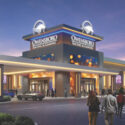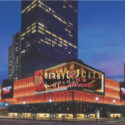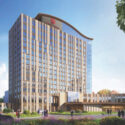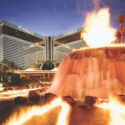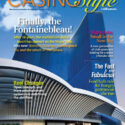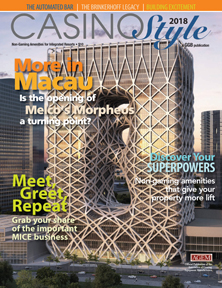
Unless you missed the headlines of the past several years about announced and completed development projects, it’s no surprise that non-gaming amenities are the focus of capital spend for existing gaming facilities. These non-gaming projects continue to get bolder, and (in some cases) bigger and better.
Whether it’s through sheer development size or diverse and dramatic elements, non-gaming amenities have evolved into something more than just a necessary evil and financial loss center for gaming resorts. Super amenities have arrived, and they’re here to stay.
In December 2015, the Poarch Band of Creek Indians opened a $246 million expansion at its Wetumpka, Alabama property that includes an iconic 360-degree aquarium at the facility’s center bar. In October 2017, Wynn Resorts announced its plan for Paradise Park—a dramatic lagoon and outdoor park area with a mile-long boardwalk. In February 2018, Las Vegas Sands and the Madison Square Garden Co. announced plans to build the MSG Sphere—a 360-foot-tall, 500-foot-wide arena. In March 2018, the Pechanga Band of Luiseño Indians officially unveiled its $300 million expansion that includes a 4.5-acre pool complex, a two-level luxury spa, and the 40,000-square-foot Pechanga Summit.
While some of the first diversified gaming experiences relied on relatively “standard” amenities such as traditional food and beverage outlets and box-style meeting space, gaming properties can no longer rely on cookie-cutter non-gaming amenities.
“At first, it was inexpensive food, hotel rooms and entertainment,” explains Rich Emery, president of Thalden Boyd Emery (TBE) Architects. “Later, a wide variety of amenities appeared to seduce new customers and keep older ones.”
Now, both destination and regional gaming facilities are expanding their non-gaming offering to include unique amenities such as Topgolf, social bowling experiences and indoor water parks, among others. Properties considering any non-gaming expansion must now focus their development on differentiated offerings more than ever.
The Non-Gaming Gold Standard
The chart below illustrates a fact that’s not new in the gaming world—Las Vegas is the gold standard when it comes to non-gaming amenities and, perhaps, the global standard for the entertainment industry in general.
 Non-gaming revenue as a percent of total Strip revenue reached an all-time high in 2017 at 66 percent of total revenue. This comes as Strip properties continue to jockey for a larger share of the seemingly ever-increasing flow of visitors to the destination—visitors who are seeking a one-of-a-kind experience that often involves minimal time spent on the gaming floor, if any.
Non-gaming revenue as a percent of total Strip revenue reached an all-time high in 2017 at 66 percent of total revenue. This comes as Strip properties continue to jockey for a larger share of the seemingly ever-increasing flow of visitors to the destination—visitors who are seeking a one-of-a-kind experience that often involves minimal time spent on the gaming floor, if any.
From eSports arenas to social bowling venues, Las Vegas integrated resorts continue to reinvent themselves from a non-gaming perspective. Recognizing the revenue split of non-gaming to gaming, the focus on non-gaming innovation is justified.
In terms of absolute floor space, gaming floors undoubtedly continue to shrink as a percentage of total floor space within integrated resorts, from already minuscule levels—frequently less than 5 percent of total gross floor area.
Throughout its history, Vegas has transformed itself from the epicenter of gaming to the epicenter of entertainment. Is its transformation a sign of things to come for gaming markets throughout the rest of the U.S.?
Recognizing that gaming revenue will be the main driver for the top lines of regional properties for the foreseeable future, how then can these properties learn from the Vegas bellwethers and other regional players?
Insights from Recent Developments
Examining the completed and announced non-gaming amenity developments over the past several years from forward-looking developers and operators reveals key considerations for future non-gaming development.
Growth opportunities lie with new customer segments.
From eSports arenas to arcades to diverse pool concepts, integrated resorts are increasingly looking to draw customers from outside the baby boomer demographic. They’re doing so with novel amenity concepts.
The rise of eSports-oriented amenities is a clear trend targeting the much-discussed and elusive (to gaming floors) millennial customer segment. This bet on eSports appears to be warranted. A 2017 study completed by Limelight Networks found that 22 percent of American millennials polled say they regularly watch competitive gaming, and that males between the ages of 18 and 25 in the U.S. say they prefer eSports over traditional sports.
Luxor’s recently opened eSports Arena Las Vegas is one of the latest eSports-only developments on the Strip. The 30,000-square-foot arena represents one of the many new faces of non-gaming for integrated resorts.
Las Vegas represents perhaps one of the best environments for eSports, as the city welcomes more than 40 million visitors per year. Without a major tourist base like this one, it remains to be seen whether significant eSports amenities can be successful at regional gaming properties outside of millennial-dense urban centers or travel destinations.
No matter the location, many gaming properties need to focus on customer segments outside the core gamer to thrive. Providing an atmosphere that pleases a diverse set of patrons is key to expand a property’s customer base.
While the millennial customer segment may not be available as a target customer for regional gaming properties, one demographic group available to many gaming properties is the family.
Throughout the U.S., more and more gaming properties are introducing one-stop, family-oriented entertainment destinations.
A non-gaming element that is increasingly common at regional gaming resorts is the movie theater. “We have recommended and built movie theaters in several casino properties. They have been very financially successful,” says Emery. “It not only draws new customers to the casino to be more familiar with the property, but is also a place to drop the kids off for a couple of hours while Mom and Dad are focused on slot machines.”
Some operators are rethinking conventional gaming resort amenities to attract a diverse group of customers. An example of this is the pool. The pool amenity is often built to capture one of two seemingly opposite customer segments: the younger patron in search of fun and entertainment, and the older patron visiting the resort, perhaps with family, in search of rest and relaxation.
To capture one of these two segments, many properties have historically created an atmosphere that caters to only one—a pool-party atmosphere to capture the younger demographic, or a spa-style pool to capture the older demographic.
More recently, however, properties are creating pool areas that offer value to a diverse set of patrons. One such example is the Cove, a 4.5-acre pool area that was part of Pechanga’s recently completed $300 million expansion project.
“Pechanga has done an incredible pool area where they’re trying to retain families and party pool millennial guests as well as guests that want to watch the party pool but not participate,” says Julie Brinkerhoff-Jacobs, president and CFO of Lifescapes International. “(The Cove) has multiple, segmented areas that cater to each of these guest segments.”
There’s an important caveat to consider as properties expand their customer base with non-gaming amenities, especially through the targeting of families: Don’t forget your core customer. Experts stress that creating an overall theme for a casino resort that strays too far from the core gaming customer can be a fatal flaw.
“Children-oriented amenities can work in certain markets and attract family customer segments,” explains Emery. “It’s important to not design the facility around them, though. The goal is to accommodate (children), not cater to them.”
Regional properties must give outer-market visitors a compelling reason to visit.
When targeting customers from outer markets, it’s imperative for regional and local gaming properties to offer a compelling reason to visit. As many of these properties compete with metropolitan areas that can provide a diverse set of leisure and entertainment offerings, gaming properties must provide something more than a steakhouse and mediocre entertainment to entice outer-market visitors to make the one- to two-hour drive to their properties.
“Many of our clients are proximate to metropolitan areas but they’re not in the metropolitan areas,” says William “Dike” Bacon, principal of HBG Design. “Their opportunity and challenge is to create interest and desire for sophisticated customers from metropolitan areas to drive to their facilities.”
Continuing to innovate and positioning themselves as one-stop shops for entertainment is crucial for regional casino properties to capture and retain outer-market visitors. For gaming customers, “the key phrase is ‘stay and play,’” says Emery. “More amenities means more to do and more reason for outer customers to make a visit.”
From an entertainment perspective, attracting and securing a diverse set of entertainers (and at the right cost) can be a major differentiating factor for regional gaming properties, even if they’re competing with urban centers. After all, there are few city-center destinations that can offer dinner from a high-quality restaurant, a show from a well-known entertainer, a potential nightcap on the gaming floor, and a hotel to spend the night in, all under one roof.
Not only can regional casino resorts offer a diverse set of amenities to patrons, they can also offer them to potential entertainers. According to experts, this is a negotiating tool that many regional gaming operations often overlook.
“Regional casinos very often won’t have the budget to compete with urban venues, but they have the amenities to compete,” says Clinton Billups, a veteran professional manager in the entertainment industry. “Casinos can offer premium ground transportation, food and beverage, and luxury accommodations among other amenities that venues like performing arts centers, universities and municipal arenas can’t compete with.”
Super amenities come in all shapes and sizes.
Don’t let the term “super amenity” fool you. Super amenities don’t have to be super in size, though they often are—particularly in Las Vegas. Perhaps the largest non-gaming amenity to be recently announced is the Paradise Park project under construction by Wynn Resorts in Las Vegas. The project will replace the 130-acre golf course to the east of the company’s existing hotel towers with a lagoon that is expected to be roughly three times the size of Bellagio’s lake. The plans include a boardwalk and beach as well as a hotel tower with up to 3,000 rooms. Projects like Paradise Park and the MSG Sphere will certainly drive more non-gaming visitors to Las Vegas for years to come.
Moving away from the Strip, regional gaming properties reveal that non-gaming amenities don’t have to be massive to be super. The Pala Casino Spa & Resort in North San Diego County introduced a wine cave in recent years. This is a fitting additional non-gaming amenity, as the greater area seeks to position itself as a “wine country” destination similar to Northern California.
The new Ocean Resort Casino in Atlantic City seeks to capitalize on the growing popularity of Topgolf without the space required for a full-scale Topgolf range. The resort will offer the world’s largest Topgolf Swing Suite, which will include 11 golf-simulator bays. At less than 30,000 square feet, the amenity is large, but significantly smaller in scale compared a full-fledged Topgolf range.
Elsewhere, there has been a trend of introducing “food hall” food and beverage concepts at regional gaming properties. From an operator’s perspective, these offer an attractive speed of service, allowing gamers to return to the casino floor quickly, and a similar footprint to quick-service food courts. From a patron’s perspective, these concepts offer a diverse set of higher-quality food offerings—from wood-fired pizza to specialty ethnic cuisine to specialty cocktails.
“Food courts have generally always offered the same things,” notes Emery. “The food halls are getting past that and getting to much higher-quality food and unique items that the casino customer isn’t used to.”
Are Super Amenities Super Investments?
Super amenities may draw press coverage and attract a new type of customer to gaming properties, but are they financially viable? And, perhaps more importantly, does it matter if they represent financially attractive investments on paper?
It is true that these so-called super amenities may not be for every property. “TBE’s research suggests that building a parking garage shows the highest return on investment for gaming properties,” Emery says. “Our recommendation has always been to build the amenities with the greatest return on investment first. Then you can afford to build the other things that may be desired but are less profitable.”
While a successfully operated hotel project at a casino resort, for example, will generally have a cash-on-cash return of three to five years, it may take developers of some of the more atypical super amenities longer to recoup their investments. However, anecdotal evidence suggests that some resort elements in this new class of amenities, such as movie theaters and tech-infused golf ranges (with capital costs ranging from roughly $10 million to $50 million, respectively), provide very strong financial returns.
Given the small sample sizes, it remains to be seen whether the success will translate from market to market. For regional and local properties that have all of the “necessary” amenities, such as a parking garage and hotel, how can they financially rationalize investing in a super amenity?
“It is a rigorous financial debate,” says Bacon. “Oftentimes it’s almost impossible to completely quantify the ROI on something that is a statement, is memorable, and creates an iconic definition for a facility that is used in multitudes of ways to inform its brand.”
For an industry on a never-ending quest to maximize financial efficiencies, that may not be the ideal answer. However, for facilities that have the financial ability to explore and create these super amenities, it may be worth it—whether it pencils out financially or not.
Commenting on one of the first super amenities, the Fountains at the Bellagio, Bacon says, “Those fountains have been running for years and years, and the sidewalk is still packed when they come on. Something like these fountains can become an iconic element that defines the notion of what a resort’s experience is.”



